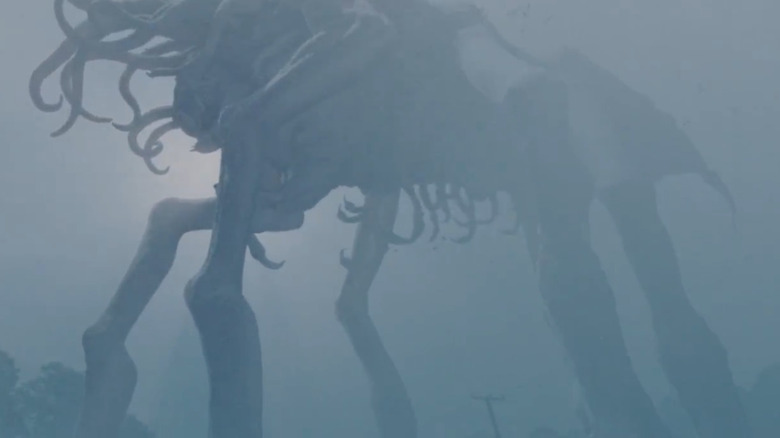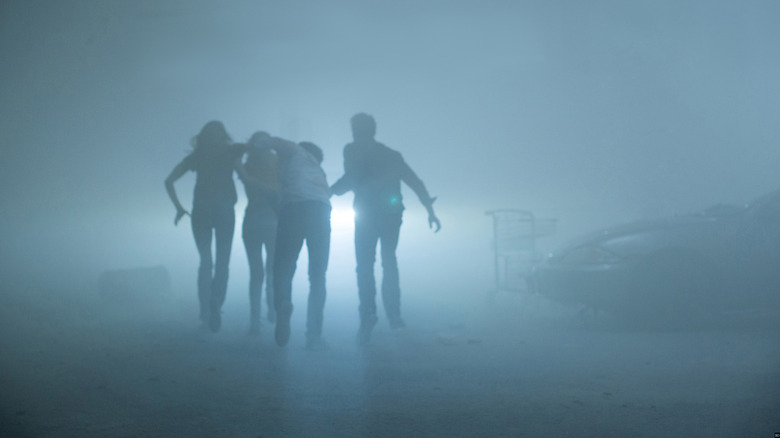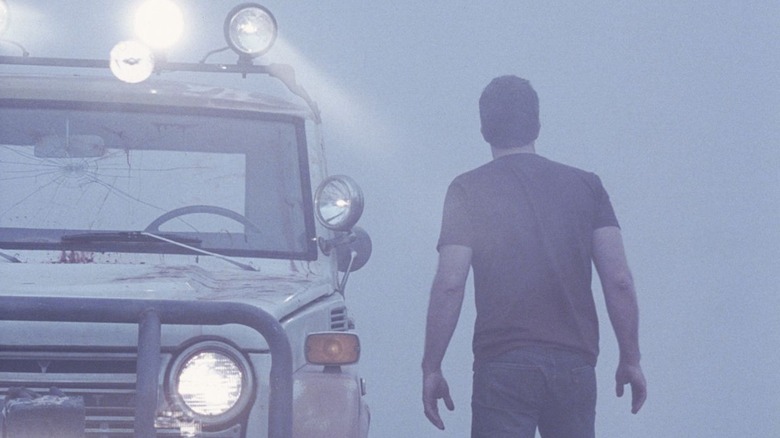Why Stephen King Was Regretful (And A Little Envious) Over The Mist's Movie Ending
This article contains spoilers for "It" and "The Mist."
Stephen King has long been criticized — usually playfully — for his inability to conjure satisfying endings to his ambitious horror tales. This criticism is so widespread that King himself has goofed on it: in Andy Muschietti's 2019 film "It Chapter Two," based on King's 1986 super-novel, James McAvoy plays an author who also notoriously can't finish his stories well. King makes a cameo appearance as a cantankerous thrift shop owner ... who says to McAvoy's face that his endings suck.
Perhaps fittingly, the ending of King's original "It" also sucks. It involves the main characters, all adults, confronting a giant spider monster in a sewer by burrowing into its body and crushing its heart. This confrontation was paralleled by a scene of the same characters as 12-year-olds fleeing the same monster years earlier. King fans will cringe to tell you what happened in the sewer pipe on the way back to the surface after the battle. It's not a good ending. Only one screen adaptation of "It" — the 1998 Indian TV series "Woh" — altered the ending for the better. In that show, it was revealed that the evil cosmic clown Pennywise was actually the vengeful spirit of a man who had been bullied to death years before.
"The Mist" is another example of a King story being improved in adaptation. King's original 1980 novella "The Mist" ends on a note of hope, the lead characters finding signs that humans might have survived a monstrous sci-fi cataclysm. The celebrated 2007 film version of "The Mist," written and directed by Frank Darabont, ends on a much, much bleaker note.
In a 2023 interview with SyFy, Darabont admitted openly that King prefers the bleak ending over his own.
To elucidate...
"The Mist," both the novella and the film, take place in a small New England town that is mysteriously enshrouded by a near-opaque mist. Hiding in the mist are hundreds of strange creatures that don't resemble any known animal. There are outsize insects, stompy monstrosities, and murderous octopodes. The locals hide out in a local grocery store, unsure as to what's happening. Not-so-slowly, a crazed fundamentalist takes over the crowd, convincing them that the mist is divine retribution and that human sacrifices need to be made.
In the novella, the protagonist — a man named Dave — flees the growing religious paranoia in the grocery store and makes it to his car outside, able to evade the monsters. He drives into the mist, seeing that it might extend far further than his town. He thumbs through the radio, listening for a human voice. He hears one.
In the movie, Dave and a few other survivors likewise flee the grocery store and flee into the mist, but there is no voice on the radio. Indeed, he and the other survivors seem to sense that the mist really spells out the apocalypse. Dave uses his last remaining bullets to kill the other survivors out of mercy, and then leaves the car, hoping for death at the talons of the monsters. It's then that the military shows up to rescue him. It's a deliciously grim ending. Darabont recalled showing his script to King, seeking the author's blessing. Darabont said:
"He also said, 'I think every generation needs a movie 'like Night of the Living Dead' where nothing turns out well for anybody at the end. Where everybody dies. [...] knew I had Stephen King's approval on this ending, so I knew I was on solid ground."
Solidly bleak.
King's precedent
The ending Darabont went with, it so happens, merely fulfilled a promise in King's novella. In King's version, Dave fled the scene with several other survivors, briefly taking stock of his gun. In a bleak realization, he realized that, if things got really, really bad, he had enough bullets to put the other survivors out of their misery. In the story, however, he doesn't have to use it. In the film, he did. Darabont would have constructed a bleak enough ending if Dave (played by Thomas Jane) also got eaten by creatures, but he decided to put the thumbscrews to the audience, making Dave's act of killing wholly unnecessary.
Darabont explained his thinking to SyFy, saying:
"King's character is weighing the worst case scenario and I seized upon that. [...] Because I thought, 'If we're gonna make a horror movie based on a Stephen King story, let's take Steve's most horrible, dour, and darkest thought and follow it out to its logical conclusion ... It really is from Stephen King, although he himself didn't realize it until I read that line back to him."
The 2007 version of "The Mist" has grown into a well-regarded horror classic, and was popular enough to inspire a TV series in 2017. In that series, the premise was changed slightly. It wasn't just monsters in the mist, but demonic spirits who take the form of a victim's worst fears. The visions, in some cases, actually help their human hosts.
The best adaptation of "The Mist" actually came in 1984 when the venerable audio drama studio, the ZBS Foundation, adapted "The Mist" into a supremely creepy soundscape. That version was recorded in 3D sound, a process that made it sound like actors were all around you (provided you wear headphones).


